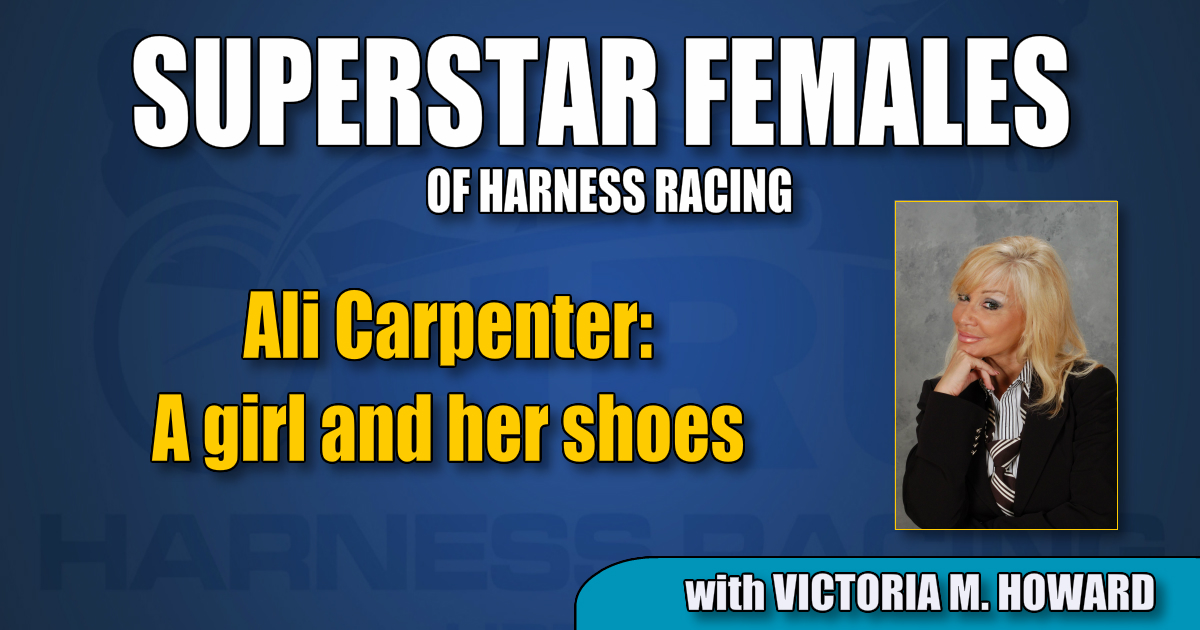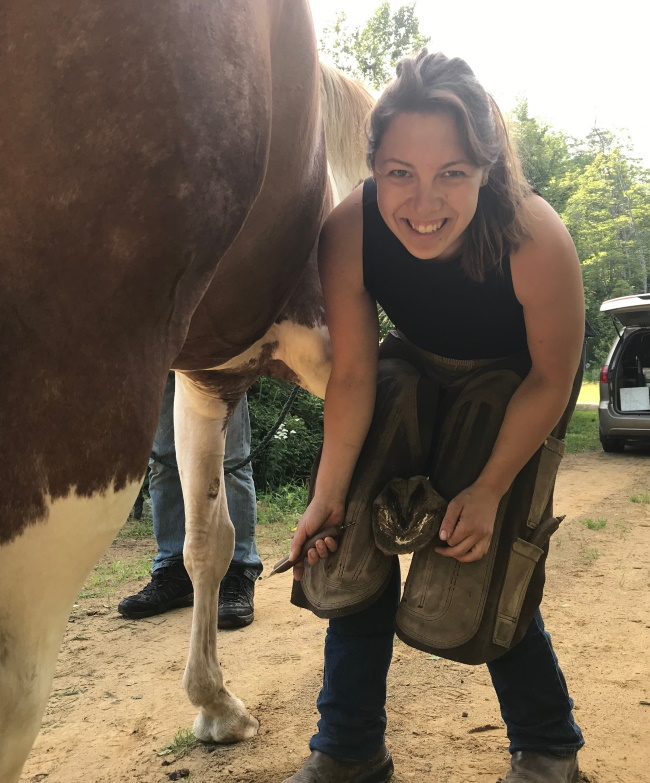

Ali Carpenter – A girl and her shoes
by Victoria M. Howard
Some women love shoes, with some owning as many as 50 pairs at a time.
But a young woman from Guelph, ON surpasses most of them. She is surrounded by hundreds of shoes, just not designer brands such as Gucci, Christian Louboutin or Jimmy Choo. Ali Carpenter’s shoe collection is predominantly made of steel. She is among the very few female carriers.
In a survey taken in 2014 by the American Farrier’s Association, only six per cent of full-time farriers were women.
Starting a little later in life than other farriers, Carpenter decided to make a career of shoeing horses when she was 27.
Growing up around cow ponies on the family farm, her grandfather worked horses in the bush and her great-grandfather was a blacksmith.
“I always had the idea of being a farrier in the back of my mind but never believed I could or should do it, so I tried a million different things first. I have 2 diplomas and a Bachelor of Science—all in agriculture and equine sciences,”Carpenter said.
“When I was a teenager I bought a horse with a crooked leg — probably one of the dumbest things you could do. When my horse went lame barefoot, the vet prescribed a pretty severe lateral extension: something simple, yet, something I had never heard of.
“After my blacksmith built a special shoe and I noticed a significant difference in my horse, a light bulb went off in my head that I wanted to be a farrier.
“I enrolled and attended Heartland Horseshoeing School in Lamar, Missouri, for eight weeks where I shod many horses. I return there periodically to continue my education when time permits, and also attend forging clinics. In fact, I compete at forging and horseshoeing contests throughout Eastern Canada and the North Eastern United States.”
Still considered “a man’s job” by many, most trainers welcome a women farrier and treat them as equals.
“The only thing that matters to them is shoeing the horse properly. Yes, there are some who still believe it’s an ‘old boys’ club’ and treat me as if they’re above me; or will hire a woman apprentice trying to prove a woman can’t do it; but in general, as long as I get the job done properly, they’re okay with it.
“In fact, there are women farriers who compete internationally and wipe the floor with their male competitors — proving women are definitely equal and capable.
“In my opinion the real problem is the clients — they are the ones that have more of a push back than fellow carriers.
“On the other hand, the race industry seems to have issues with females under horses because we are few and far between, for reasons I don’t understand.
“In race barns I seem to get the most negative comments, and also where I get the most blatant sexual harassment. Shoeing horses is still viewed a man’s profession and I’m often questioned incessantly as to why I would ever want to do it.
“The funny thing is that when I work with riding horses I don’t tend to get those comments — or if I do, it’s positive.
“I am very lucky to live in an area where there is a strong female presence with a group of over 40 female farriers in Ontario. We try to get together once or twice a year to hang out and socialize, and I’ve made many good friends with other female blacksmiths.”
Shoeing horses is not a glamorous job and very laborious. It requires holding a 1,000-pound animal — sometimes up to 20 plus horses a day — which can take its toll on your body.
“If you do it properly the horse holds their weight and you just have to deal with the weight of the hoof in your lap. The bending over is a strain on your back, but you can transfer the workload to your body and use your muscle groups to help save your body,” Carpenter said.
“Position is the key. As you get tired, you do tend to get sloppy and will fall back into your back. I work out regularly, which helps strengthen the supporting muscles, which in turn helps keep you from hurting yourself.
“Every day is a long day. Depending on the day, I may shoe six to eight hours a day — that’s not to say I haven’t been out shoeing past my bedtime.”
Wrestling with a 1,000-pound animal can be quite dangerous. Especially when you’re working with the youngsters.
“Yearlings are for sure the most difficult to shoe, for everything is new to them. They are used to living outside playing with their friends — running around and burning off their energy.
“Then they get tossed in a stall and have to learn how to be a horse. They don’t understand what we’re doing; the sensation is new, the way we ask them to stand is new, and they don’t know how to stand on three feet.
“You have to be in a good mental state to shoe the babies or else you’ll get hurt.
“And the job can be dangerous. One time, a piece of hot steel got in my eye and another time I was thrown 20 feet into the air.
“I’ve been bit, kicked, and stomped on — but horses that bite are the worst.
“Being a female blacksmith there are ways to get around the fact that I’m not a 250 lb. man. Instead of being macho, women learn ways of staying in control of a horse that requires less strength and convincing the horse to do it for us.
“For example, the hind limb of a horse has a reciprocal apparatus. When one joint flexes — all the joints of the hind limb flex — and you use that to your advantage when trying to get a leg from a horse that won’t cooperate.
“Or if you hold the toe of a hoof flexed, you have control of that leg with very little effort on your behalf to keep the foot, and you don’t have to fight them.”
Being a farrier can be dangerous, it’s not as glamorous and respected as a trainer or driver and it takes its toll on your body. So why does Carpenter do it?
“I love what I do, enjoy working with these amazing creatures and wouldn’t trade if for anything in the world.”
















